
This is little gem of a show: small but flawless, perfectly formed and expertly cut.
Superficially this seems to be a very simple children’s story. On closer examination it is not written entirely for children. It is a story told on multiple levels, put together with exquisite craftsmanship, with subtle symbolism and wonderful characters. It is a remarkable piece of work–every time I rewatch an episode I am impressed again by how well it is done.
-
Original TitleKAADO KYAPUTAA Sakura
-
GenresFantasy, Comedy, Magical Girl
-
DemographicShoujo
-
Contents70 episodes on 18 DVDs (2 boxed sets) plus 2 movies
-
LanguagesJapanese with subtitles
-
Based onA manga by CLAMP
-
Supervising DirectorMorio Asaka
-
Script SupervisorNanase Ohkawa (CLAMP)
-
Animation StudioMadhouse
-
BroadcastNHK, 1998-2000
-
Region 1 PublisherGeneon
Most magical girl stories follow a common pattern: a young girl gains some magic powers, defeats some monsters, saves the world and learns some Important Lessons. This one is no different, but it is the gold standard against which the others must be measured, and compared to which most will fall short.
The most remarkable thing about this series is that the writers clearly knew when they wrote the first episode exactly how they intended to end it, and exactly what steps they would have to go though to get to that ending. Such careful planning is common in a short 13-episode series, and somewhat less common in a full-season 24-episode series. To see it in a series that spans three years and 70 episodes is very rare.
Usually a multi-year series is a sprawling mess that the writers make up as they go along, featuring numerous inconsistencies, forgotten characters, dangling plot threads, and finally a hastily thrown-together ending. This one is different. Everything fits together into a seamless whole. To make it one episode shorter or one episode longer would have diminished it.
Beware of the Dub
Sometimes bad things happen to good anime. For proof we need only look at what happened to it when it was first licensed for the North American region. A re-edited version was created and broadcast on the WB Kids network, dubbed in English with a rewritten script.
The show was cut and re-edited to reduce Sakura’s role; the characters were given Anglo names and standard American sitcom personalities; much of the distinctively Japanese material was removed and the writing was dumbed down to conform to the standards of American television. (Some of the cut material was later restored when the show was broadcast in other countries.) The setting was changed to a mythical town in America, apparently one where the signs are written in Japanese.
The reasons for doing this may to some extent have involved cultural differences about what is appropriate to include in a television show watched by children. However it seems clear that the changes were mainly made for marketing reasons: the producers wanted to market the program to boys, and they were afraid that American audiences would not like being exposed to a foreign culture.
The dubbed version is available on DVD under the name Cardcaptors. I recommend avoiding it at all costs. Even if you don’t believe that it is reprehensible to butcher a work of art in the hope of making more money from it, the dubbed version is not worth your time. Everything that makes the original version great has been lost.
Fortunately Geneon has released the real Japanese version with English subtitles under the name Cardcaptor Sakura. Show your appreciation by renting or buying the DVDs. (The boxed sets are among the best bargains in anime, especially if you wait for a sale.)
Usually with anime DVDs you have the choice of watching with subtitles or putting up with generally inferior American voice acting. In this case there really is no choice. It’s subtitles or nothing.
(UPDATE: There is a rumor that Geneon’s license is about to expire and that they may not renew it. If that happens the DVDs may quickly become hard to find.)
The Controversy
The release of the dubbed version had an unfortunate side effect. The fans of the original series greeted it with outrage. The people responsible for the dub defended themselves by claiming that they made the changes to protect American children from unsuitable content. This helped give the original series an undeserved lurid reputation.
The truth is that most of the cut material is totally innocuous and nothing in the remainder is even slightly indecent. The series may contain a few things that Americans are not used to seeing in cartoons, but there is nothing nearly as shocking as some of the things that are broadcast every evening on American television.
If you go through the series with a fine-toothed comb, decoding all the hidden meanings and interpreting everything in the most negative possible way, you will doubtless find something to offend you. However anyone who does that must surely be offended by most popular culture (either American or Japanese) and really shouldn’t be watching anime anyway.
Synopsis
Clow Card Arc: Episodes 1-46
Sakura accidentally scatters some magic cards and is given the dangerous task of retrieving them.
Sakura Card Arc: Episodes 47-70
Sakura thinks her troubles are over (not noticing that several plot threads remain unresolved.) She is soon confronted with a new set of problems.
The Movies
Two movies were released in theaters to cash in on the popularity of the television series. Both are available on DVD. Neither one is essential to the story, but they are fairly well done and the first one provides some interesting additional background information.
Cardcaptor Sakura: The Movie
Sakura and her friends visit Hong Kong and are confronted by a threatening presence. This story fits neatly between episodes 35 and 36, which corresponds to the gap between the first and second seasons in the original Japanese broadcast schedule. In the American releases this corresponds to the gap between DVDs 9 and 10, or between the two boxed sets.
The American DVD includes an English soundtrack in which the script has been rewritten to match the Cardcaptors story line. Naturally it should only be watched in Japanese with subtitles.
Cardcaptor Sakura Movie 2: The Sealed Card
It seems that there was one more card that nobody knew about…
This story is set several months after the conclusion of the television series and attempts to provide a more definitive ending. The movie is aimed strictly at the fans of the television series. The trouble is that many of these fans consider the original ending to be perfect and will find the new ending superfluous.
This is the only American DVD in which the English dub matches the original Japanese script, but I would think that the sort of fans who would be interested in the movie would want to hear the original Japanese cast.
There are actually two versions of the American DVD release. The more expensive “Special Edition” contains an extra Kero-chan cartoon that will delight fans. (To find it, go to the “Extras” menu, scroll down to the bottom, then go down one more step to reveal a hidden menu pick.)
Parental Advisory
I consider this suitable for any child who is old enough to read the subtitles. Children younger than that might find some elements disturbing, particularly two episodes that touch on the death of a parent.
The series has no sexual situations and limited violence. Action sequences are bloodless and stylized, though they are often more emotionally intense than bloodier sequences seen in other series. (This surely says something about the skill of the animators.)
This leaves the “controversial” matters mentioned above. There are things going on below the surface of the story, things that a child probably would not notice or understand. Some of these things may be disturbing to some adult viewers.
As a parent the final decision has to be yours, but I don’t think these amount to a good reason to keep a child from watching this series. Considered in its entirety this is a very wholesome and life-affirming story.
Girls will appreciate the strong but feminine female characters. Boys will probably be repulsed by the overly girly opening and closing credit sequences, but if they stick around for the actual show they will find much to like, including some admirable male characters. (It might be a good idea to use the “skip” button on the remote control for the credit sequences. Most people consider them the weakest part of the show.)
Premise and Characters
 Sakura Kinomoto is a fairly average 10 year old girl. She likes sports and music, and struggles with math. She is a cheerful girl, though unusually thoughtful and responsible for her age, and she doesn’t have much of a sense of humor. She also isn’t very brave, or at least she doesn’t think she is.
Sakura Kinomoto is a fairly average 10 year old girl. She likes sports and music, and struggles with math. She is a cheerful girl, though unusually thoughtful and responsible for her age, and she doesn’t have much of a sense of humor. She also isn’t very brave, or at least she doesn’t think she is.
 One day Sakura finds a strange book containing a deck of mysterious cards. When she opens the book to examine the cards, a great wind blows all but one of them away.
One day Sakura finds a strange book containing a deck of mysterious cards. When she opens the book to examine the cards, a great wind blows all but one of them away.
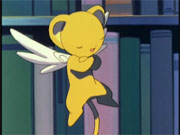 Kerberos the Beast of the Seal (KERUBOROSU, also known as “Kero-chan”) was supposed to be guarding the cards, but he happened to be taking a short nap when Sakura found them. He tells Sakura that the cards are dangerous and that she must assume the role of the “Cardcaptor” and recover them, or “a catastrophe will befall this world.” Sakura wants to do nothing of the sort, but she is not the sort of girl who would stand by and let a catastrophe occur.
Kerberos the Beast of the Seal (KERUBOROSU, also known as “Kero-chan”) was supposed to be guarding the cards, but he happened to be taking a short nap when Sakura found them. He tells Sakura that the cards are dangerous and that she must assume the role of the “Cardcaptor” and recover them, or “a catastrophe will befall this world.” Sakura wants to do nothing of the sort, but she is not the sort of girl who would stand by and let a catastrophe occur.
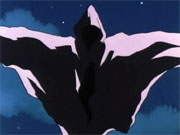
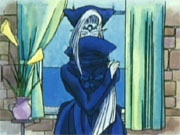
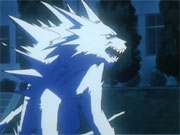
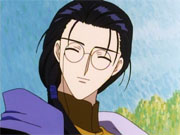 Clow Reed, the creator of the cards, was the greatest wizard of the early twentieth century. He died decades ago but his memory haunts the story. Kerberos speaks of him with a mixture of awe and bitterness, and the viewer is led to wonder what sort of man would have created such dangerous cards, and for what purpose?
Clow Reed, the creator of the cards, was the greatest wizard of the early twentieth century. He died decades ago but his memory haunts the story. Kerberos speaks of him with a mixture of awe and bitterness, and the viewer is led to wonder what sort of man would have created such dangerous cards, and for what purpose?
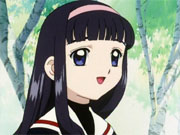 Sakura’s best friend Tomoyo Daidouji soon finds out that she is trying to capture the cards and insists on helping. Tomoyo is very smart and talented, the sort of girl who invariably excels at everything she tries. She is also the prettiest girl in the class, her family is extremely rich, and she sometimes seems a bit ruthless. This sounds like she would make a good villain, but in fact she is a devoted friend and Sakura relies on her support.
Sakura’s best friend Tomoyo Daidouji soon finds out that she is trying to capture the cards and insists on helping. Tomoyo is very smart and talented, the sort of girl who invariably excels at everything she tries. She is also the prettiest girl in the class, her family is extremely rich, and she sometimes seems a bit ruthless. This sounds like she would make a good villain, but in fact she is a devoted friend and Sakura relies on her support.
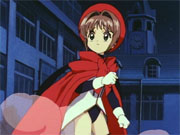
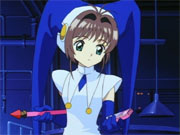
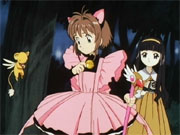
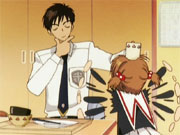 Sakura thinks that her older brother Touya Kinomoto is very mean. He calls her a kaijuu (giant monster) which makes her absolutely furious! She is determined to keep him from finding out about the Clow Cards.
Sakura thinks that her older brother Touya Kinomoto is very mean. He calls her a kaijuu (giant monster) which makes her absolutely furious! She is determined to keep him from finding out about the Clow Cards.
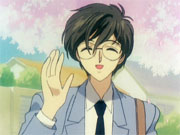 Sakura feels differently about Touya’s best friend Yukito Tsukishiro. Yukito is kind and helpful and has many talents, including the ability to eat great quantities of food. He also has classic bishounen good looks, and Sakura has a terrible crush on him.
Sakura feels differently about Touya’s best friend Yukito Tsukishiro. Yukito is kind and helpful and has many talents, including the ability to eat great quantities of food. He also has classic bishounen good looks, and Sakura has a terrible crush on him.
 Sakura’s father Fujitaka Kinomoto teaches archeology at a local university. By Japanese standards he is a rather strict and demanding father, but he is also very warm and nurturing and Sakura adores him.
Sakura’s father Fujitaka Kinomoto teaches archeology at a local university. By Japanese standards he is a rather strict and demanding father, but he is also very warm and nurturing and Sakura adores him.
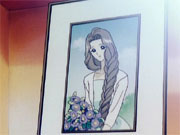 Sakura’s mother Nadeshiko Kinomoto died when she was three years old, but manages to make an occasional appearance anyway.
Sakura’s mother Nadeshiko Kinomoto died when she was three years old, but manages to make an occasional appearance anyway.
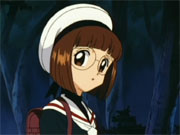 Naoko Yanagisawa is Sakura’s classmate. She is a bookish girl who likes scary stories, which terrify Sakura.
Naoko Yanagisawa is Sakura’s classmate. She is a bookish girl who likes scary stories, which terrify Sakura.
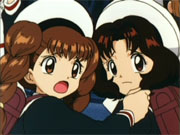 Chiharu Mihara (L) and Rika Sasaki (R) are two of Sakura’s other close friends.
Chiharu Mihara (L) and Rika Sasaki (R) are two of Sakura’s other close friends.
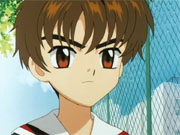 Shaoran Li is a transfer student, newly arrived from Hong Kong. He is actually a collateral descendant of Clow Reed. He believes that the cards are rightfully his and is furious that Sakura is trying to collect them. Coming from a family of magic users, he has been trained from early childhood in magic and martial arts. Having studied old books left by Clow he knows more about the cards than anyone except Kerberos. He is fierce and intense and has, if anything, less of a sense of humor than Sakura does. Sakura finds him very intimidating but tries not to show it.
Shaoran Li is a transfer student, newly arrived from Hong Kong. He is actually a collateral descendant of Clow Reed. He believes that the cards are rightfully his and is furious that Sakura is trying to collect them. Coming from a family of magic users, he has been trained from early childhood in magic and martial arts. Having studied old books left by Clow he knows more about the cards than anyone except Kerberos. He is fierce and intense and has, if anything, less of a sense of humor than Sakura does. Sakura finds him very intimidating but tries not to show it.
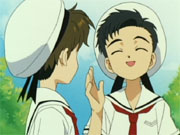 Takashi Yamazaki is Chiharu’s childhood friend. He loves telling tall tales.
Takashi Yamazaki is Chiharu’s childhood friend. He loves telling tall tales.
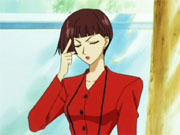 Sonomi Daidouji is Tomoyo’s mother, the hard-driving president of a toy company.
Sonomi Daidouji is Tomoyo’s mother, the hard-driving president of a toy company.
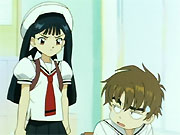 Meilin Li (Li Mei Ling) is Shaoran’s cousin and (she says) his fiancée. Unlike most members of her family she has no magical talents, but she is an excellent martial artist. She is hot-tempered, boastful and arrogant. Naturally she supports Shaoran’s claim to the cards and she takes an instant dislike to Sakura.
Meilin Li (Li Mei Ling) is Shaoran’s cousin and (she says) his fiancée. Unlike most members of her family she has no magical talents, but she is an excellent martial artist. She is hot-tempered, boastful and arrogant. Naturally she supports Shaoran’s claim to the cards and she takes an instant dislike to Sakura.
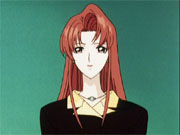 Kaho Mizuki, a new teacher at Sakura’s school, seems to know more about the cards than she ought to.
Kaho Mizuki, a new teacher at Sakura’s school, seems to know more about the cards than she ought to.
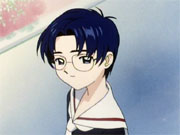 Eriol Hiiragizawa is a mysterious transfer student who shows up late in the story.
Eriol Hiiragizawa is a mysterious transfer student who shows up late in the story.
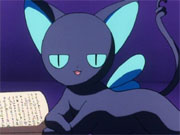 Spinel is another guardian beast.
Spinel is another guardian beast.
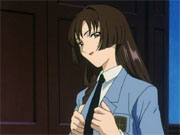 Nakuru Akizuki, one of Touya’s classmates, is an unusually aggressive girl.
Nakuru Akizuki, one of Touya’s classmates, is an unusually aggressive girl.
Links
Anime News Network.
Wikipedia article. (This has lots of information, but many more spoilers than even the usual Wikipedia entry. I strongly suggest avoiding it unless you have seen the entire series.)

